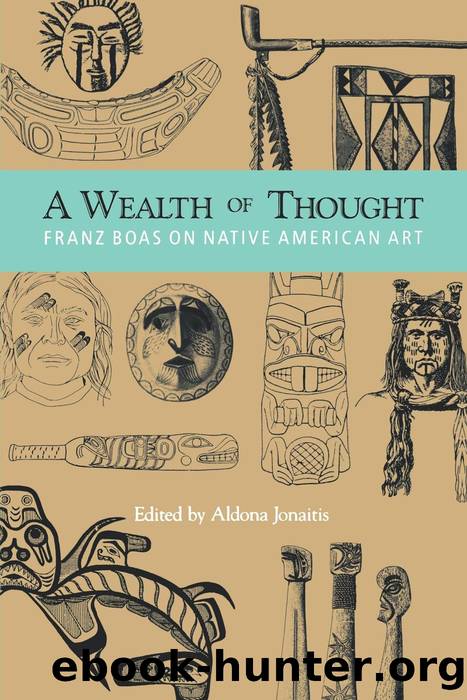A Wealth of Thought by Unknown

Author:Unknown
Language: eng
Format: epub
Publisher: University of Washington Press
Published: 2017-03-15T00:00:00+00:00
SECOND FLOOR, HALL 202
On the second floor are found collections from California and Mexico which illustrate some of the characteristics of the decorative art of these regions.
HALL 202: CASES 1â6
California Indians The decorative art of the California Indians, more particularly that of the Indians of southern California, is almost entirely confined to basketry. Their baskets are mostly round, rather rarely oblong, many of them quite shallow: consequently we find a tendency to arrange the decorative designs in radial groups or in spirals. The designs themselves are rarely realistic, but consist always of more or less intricate geometrical designs. The similarity of these designs on various baskets is quite striking. Their interpretations, however, differ considerably. A collection illustrating the similarity of design and the diversity of their meaning has been assembled in Case 2a, b. There we find on one basket a design representing a squirrelâs foot. A similar design on another basket represents mountains and pinecones; on still another, the bearâs foot; and on a fourth the owlâs claw.
In the same case are shown a number of baskets illustrating one of the most common ornamental motives found in California, the so-called quail tip, a design consisting of a slender line with a small heavy hook standing off from the end at right angles. This design was described before as found on baskets from the state of Washington (Case R 12 in Hall 108), and it seems probable that it has spread along the Pacific coast from tribe to tribe. This seems the more likely, since it is found in entirely different weaves, according to the district in which it occurs. While it is found on many Californian weaves, it is applied in the state of Washington on the peculiar imbricated basketry the characteristic designs of which are illustrated by baskets of the Thompson and Lillooet Indians (see Cases O and P, Hall 108).
The interpretations given to designs by the Californian Indians vary greatly. The designs often represent plants, while some represent fish teeth, snakes, worms, millipedes, butterflies, etc. Designs symbolic of larger animals are absent. One of the most frequently occurring designs on Californian, and perhaps on all, basketry is the feather and arrow-point design (Cases 2, 3). Realistic designs are found only in the extreme southern part of California and in the adjoining portions of Arizona.
In northern California the interpretation of designs seems to be almost absent. The patterns of this district are called âstriped,â âzigzag,â etc., terms which are evidently names, not interpretations (Case 6f).
Download
This site does not store any files on its server. We only index and link to content provided by other sites. Please contact the content providers to delete copyright contents if any and email us, we'll remove relevant links or contents immediately.
Becoming Supernatural by Dr. Joe Dispenza(8127)
Crystal Healing for Women by Mariah K. Lyons(7857)
The Witchcraft of Salem Village by Shirley Jackson(7193)
Inner Engineering: A Yogi's Guide to Joy by Sadhguru(6728)
The Four Agreements by Don Miguel Ruiz(6640)
The Power of Now: A Guide to Spiritual Enlightenment by Eckhart Tolle(5610)
Secrets of Antigravity Propulsion: Tesla, UFOs, and Classified Aerospace Technology by Ph.D. Paul A. Laviolette(5311)
The Wisdom of Sundays by Oprah Winfrey(5087)
Room 212 by Kate Stewart(5041)
Pale Blue Dot by Carl Sagan(4917)
Fear by Osho(4662)
The David Icke Guide to the Global Conspiracy (and how to end it) by David Icke(4629)
Animal Frequency by Melissa Alvarez(4399)
Rising Strong by Brene Brown(4382)
How to Change Your Mind by Michael Pollan(4292)
Sigil Witchery by Laura Tempest Zakroff(4181)
Real Magic by Dean Radin PhD(4077)
Man and His Symbols by Carl Gustav Jung(4070)
The Art of Happiness by The Dalai Lama(4064)
